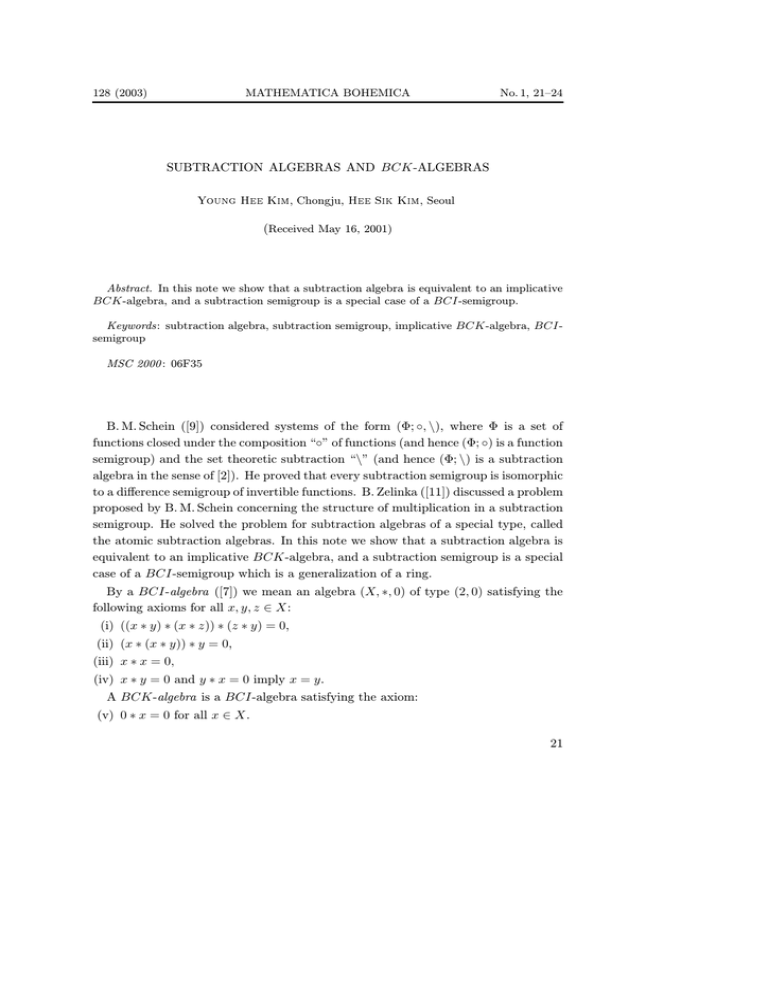Document 10524213
advertisement

128 (2003)
MATHEMATICA BOHEMICA
No. 1, 21–24
SUBTRACTION ALGEBRAS AND BCK-ALGEBRAS
, Chongju,
, Seoul
(Received May 16, 2001)
Abstract. In this note we show that a subtraction algebra is equivalent to an implicative
BCK-algebra, and a subtraction semigroup is a special case of a BCI-semigroup.
Keywords: subtraction algebra, subtraction semigroup, implicative BCK-algebra, BCIsemigroup
MSC 2000 : 06F35
B. M. Schein ([9]) considered systems of the form (Φ; ◦, \), where Φ is a set of
functions closed under the composition “◦” of functions (and hence (Φ; ◦) is a function
semigroup) and the set theoretic subtraction “\” (and hence (Φ; \) is a subtraction
algebra in the sense of [2]). He proved that every subtraction semigroup is isomorphic
to a difference semigroup of invertible functions. B. Zelinka ([11]) discussed a problem
proposed by B. M. Schein concerning the structure of multiplication in a subtraction
semigroup. He solved the problem for subtraction algebras of a special type, called
the atomic subtraction algebras. In this note we show that a subtraction algebra is
equivalent to an implicative BCK-algebra, and a subtraction semigroup is a special
case of a BCI-semigroup which is a generalization of a ring.
By a BCI-algebra ([7]) we mean an algebra (X, ∗, 0) of type (2, 0) satisfying the
following axioms for all x, y, z ∈ X:
(i) ((x ∗ y) ∗ (x ∗ z)) ∗ (z ∗ y) = 0,
(ii) (x ∗ (x ∗ y)) ∗ y = 0,
(iii) x ∗ x = 0,
(iv) x ∗ y = 0 and y ∗ x = 0 imply x = y.
A BCK-algebra is a BCI-algebra satisfying the axiom:
(v) 0 ∗ x = 0 for all x ∈ X.
21
We can define a partial ordering 6 on X by x 6 y if and only if x ∗ y = 0. In any
BCI-algebra X, we have
(1) x ∗ 0 = x,
(2) (x ∗ y) ∗ z = (x ∗ z) ∗ y,
(3) x 6 y imply x ∗ z 6 y ∗ z and z ∗ y 6 z ∗ x,
(4) (x ∗ z) ∗ (y ∗ z) 6 x ∗ y
for any x, y, z ∈ X.
A subtraction algebra is a groupoid (X; −) where “−” is a binary operation, called
a subtraction; this subtraction satisfies the following axioms: for any x, y, z ∈ X,
(I) x − (y − x) = x;
(II) x − (x − y) = y − (y − x);
(III) (x − y) − z = (x − z) − y.
Note that a subtraction algebra is the dual of the implication algebra defined by
J. C. Abbott ([1]), by simply exchanging x − y by yx. If to a subtraction algebra
(X; −) a semigroup multiplication is added safisfying the distributive laws
x · (y − z) = x · y − x · z,
(y − z) · x = y · x − z · x
then the resulting algebra (X; ·, −) is called a subtraction semigroup. In [9] it is
mentioned that in every subtraction algebra (X; −) there exists an element 0 such
that x − x = 0 for any x ∈ X. The proof is given by J. C. Abbott ([1], Theorem 1).
Note that x − 0 = x for any x in a subtraction algebra (X; −, 0). H. Yutani ([10])
obtained equivalent simple axioms for an algebra (X; −, 0) to be a commutative
BCK-algebra.
Theorem 1 ([10]). An algebra (X; −, 0) is a commutative BCK-algebra if and
only if it satisfies
(II) x − (x − y) = y − (y − x);
(III) (x − y) − z = (x − z) − y;
(IV) x − x = 0;
(V) x − 0 = x
for any x, y, z ∈ X.
A BCK-algebra (X; −, 0) is said to be implicative if (I) x−(y−x) = x for any x, y ∈
X. Using this concept and comparing the axiom system of the subtraction algebra
with the characterizing equalities of the implicative BCK-algebra (by H. Yutani),
we summarize to obtain the main result of this paper.
Theorem 2. A subtraction algebra is equivalent to an implicative BCK-algebra.
22
The notion of a BCI-semigroup was introduced by Y. B. Jun et al. ([5]), and studied by many researchers ([3], [4], [6], [8]). A BCI-semigroup (or shortly, IS-algebra)
is a non-empty set X with two binary operations “−” and “·” and a constant 0
satisfying the axioms (i) (X; −, 0) is a BCI-algebra; (ii) (X; ·) is a semigroup; (iii)
x · (y − z) = x · y − x · z, (x − y) · z = x · z − y · z for all x, y, z ∈ X.
3 ([3]). If we define two binary operations “∗” and “·” on a set
X := {0, 1, 2, 3} by
∗
0
1
2
3
·
0
1
2
3
0
1
2
3
0
1
2
3
0
0
2
2
2
3
0
1
2
2
0
0
0
1
2
3
0
0
0
0
0
1
0
1
0
0
2
2
0
1
2
3
then (X; ∗, ·, 0) is a BCI-semigroup.
Every p-semisimple BCI-algebra turns into an abelian group by defining x + y :=
x ∗ (0 ∗ y), and hence a p-semisimple BCI-semigroup leads to the ring structure.
On the other hand, every ring turns into a BCI-algebra by defining x ∗ y := x − y
and hence we can construct a BCI-semigroup. This means that the category of psemisimple BCI-semigroups is equivalent to the category of rings. In Example 3, we
can see that 2 + 3 = 0 6= 1 = 3 + 2 and 3 + 2 = 1 = 3 + 3, hence (X; +) is not a
group. This means that there exist BCI-semigroups which cannot be derived from
rings. Hence the BCI-semigroup is a generalization of the ring.
Since an implicative BCK-algebra is a special case of a BCI-algebra, we conclude
that a subtraction semigroup is a special case of a BCI-semigroup.
!#"%$&(' ()+*,- $%.
. The authors are deeply grateful to the referee for the
valuable suggestions and help.
References
[1] J. C. Abbott: Semi-Boolean Algebras. Matemat. Vesnik 4 (1967), 177–198.
[2] J. C. Abbott: Sets, Lattices and Boolean Algebras. Allyn and Bacon, Boston, 1969.
[3] S. S. Ahn, H. S. Kim: A note on I-ideals in BCI-semigroups. Comm. Korean Math. Soc.
11 (1996), 895–902.
[4] Y. B. Jun, S. S. Ahn, J. Y. Kim, H. S. Kim: Fuzzy I-ideals in BCI-semigroups. Southeast
Asian Bull. Math. 22 (1998), 147–153.
[5] Y. B. Jun, S. M. Hong, E. H. Roh: BCI-semigroups. Honam Mathematical J. 15 (1993),
59–64.
[6] Y. B. Jun, J. Y. Kim, Y. H. Kim, H. S. Kim: Fuzzy commutative I-ideals in BCI-semigroups. J. Fuzzy Math. 5 (1997), 889–898.
[7] J. Meng, Y. B. Jun: BCK-algebras. Kyung Moon Sa Co., Seoul, 1994.
23
[8] E. H. Roh, S. Y. Kim, W. H. Shim: a&I-ideals on IS-algebras. Sci. Math. Japonicae Online 4 (2001), 21–25.
[9] B. M. Schein: Difference semigroups. Commun. Algebra 20 (1992), 2153–2169.
[10] H. Yutani: On a system of axioms of a commutative BCK-algebras. Math. Seminar
Notes 5 (1977), 255–256.
[11] B. Zelinka: Subtraction semigroups. Math. Bohem. 120 (1995), 445–447.
Authors’ addresses: Young Hee Kim, Department of Mathematics, Chungbuk National University, Chongju 361-763, Korea, e-mail: yhkim@cbucc.chungbuk.ac.kr; Hee
Sik Kim, Department of Mathematics, Hanyang University, Seoul 133-791, Korea, e-mail:
heekim@hanyang.ac.kr.
24




